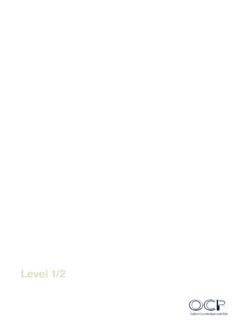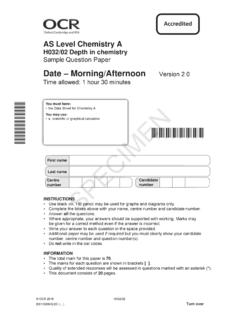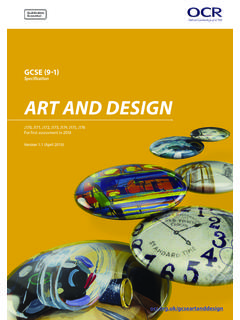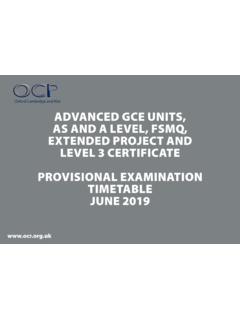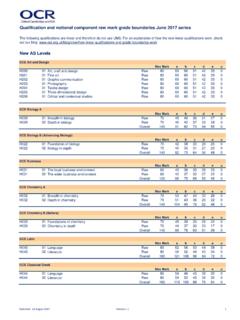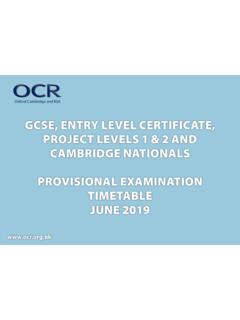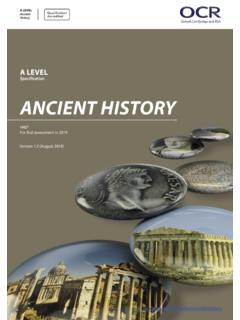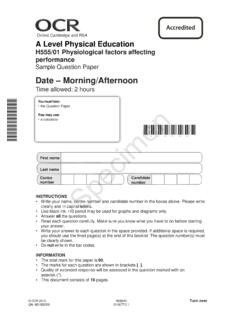Transcription of GCE Health and Social Care - OCR - awarding body …
1 Oxford Cambridge and RSA Examinations GCE Health and Social care Unit F921: Anatomy and Physiology in Practice Advanced GCE Mark Scheme for June 2015 OCR (Oxford Cambridge and RSA) is a leading UK awarding body , providing a wide range of qualifications to meet the needs of candidates of all ages and abilities. OCR qualifications include AS/A Levels, Diplomas, GCSEs, Cambridge Nationals, Cambridge Technicals, Functional Skills, Key Skills, Entry Level qualifications, NVQs and vocational qualifications in areas such as IT, business, languages, teaching/training, administration and secretarial skills. It is also responsible for developing new specifications to meet national requirements and the needs of students and teachers. OCR is a not-for-profit organisation; any surplus made is invested back into the establishment to help towards the development of qualifications and support, which keep pace with the changing needs of today s society.
2 This mark scheme is published as an aid to teachers and students, to indicate the requirements of the examination. It shows the basis on which marks were awarded by examiners. It does not indicate the details of the discussions which took place at an examiners meeting before marking commenced. All examiners are instructed that alternative correct answers and unexpected approaches in candidates scripts must be given marks that fairly reflect the relevant knowledge and skills demonstrated. Mark schemes should be read in conjunction with the published question papers and the report on the examination. OCR will not enter into any discussion or correspondence in connection with this mark scheme. OCR 2015 F921 Mark Scheme June 2015 3 Annotations Annotation Meaning Positive Negative Benefit of doubt Cross Level 1 Level 2 Level 3 Level 4 Repeat Noted but no credit given Too vague Tick Development of point Omission mark F921 Mark Scheme June 2015 4 Question Answer Marks Guidance Content Levels of response 1 a Describe the roles during inspiration of the parts of the respiratory system listed: Pleural membranes Diaphragm Intercostal muscles Pleural membranes Double-layered membrane that covers the lungs and that are also attached to rib cage and diaphragm.
3 They produce lubricating fluid that causes them to stick closely to one another. When rib cage raised and diaphragm flattened membranes cause lungs to also move up, out and downwards so increasing volume of lungs (or volume of thorax so decreasing internal pressure) and so drawing air into lungs. Cushions lungs, reduces friction Diaphragm Diaphragm is a domed muscular sheath below lungs and attached to them by the pleural membranes. During inspiration flattens/contracts and due to attachment of pleural membranes pulls down on lungs helping them to expand and inflate. 6 Level 2 Fully developed description. References to all three structures need to be included for top of Level 2. Includes accurate terminology. High QWC. Level 1 Simple description. Limited appropriate terminology Level 2 [4-6 marks] Candidates will provide a fully developed description that includes accurate terminology.
4 References to all three structures need to be included for top of Level 2. Sentences and paragraphs are generally relevant but may have minor inaccuracies or lack clarity and depth of understanding. There may be some errors of grammar, punctuation and spelling. Level 1 [1-3 marks] Candidates will describe the roles played by the structures in a limited manner or may simply describe the structures and their location. Their use of appropriate terminology will be limited. Sentences and paragraphs are not always relevant, with the material presented in a way that does not always address the question. There may be noticeable errors of grammar, punctuation and spelling and answers may be list like. 0 response not worthy of credit. F921 Mark Scheme June 2015 5 Question Answer Marks Guidance Content Levels of response Intercostal muscles Two sets of muscles between the ribs attached on one side to the rib on the top and on the other to the rib just below it.
5 During inspiration one set external intercostal muscles- contract to lift ribs and increase the volume of rib cage. Attachment of pleural membranes means lungs pulled up and out so increasing lung volume resulting in drawing air into the lungs. b i Explain how a named respiratory dysfunction affects the functions of the bronchii. Asthma muscles within bronchii contract resulting in constriction of the bronchii. Reduce/narrows/ inflamed lumen results in tightness of the chest and reduced airflow. CF goblet cells of bronchii produce very sticky abnormal mucus that clogs the tubes and reduces airflow. Inflammation usually follows resulting in further blockage. 4 X 1 F921 Mark Scheme June 2015 6 Question Answer Marks Guidance Content Levels of response Bronchitis bacteria produce mucus so congesting bronchii. Lungs produce further mucus to eliminate bacteria.
6 Reduces air flow Cancer tumours can grow in walls of bronchii causing blockages/restrictions so reducing airflow within a section of the lung. b ii Explain how this effect on the bronchii may be detected using a named diagnostic test and then be treated. Peak flow (asthma, CF, bronchitis) Measures forced expiration and measures how fast and how forceful expiration is. Constricted bronchii result in low readings Congested bronchii result in low readings Spirometry (asthma, CF, bronchitis) The spirometer takes two measurements: the volume of air 6 Level 2 Developed explanation. Includes accurate terminology. Both test and treatment will be generally accurate. Equal quality to attain top marks. Mid-QWC. Level 1 Simple explanation. Limited appropriate terminology. Test and treatment may be limited or may be one or other. Low QWC. Answers on tests that do not relate to the bronchii will not be accepted.
7 Level 2 [4-6 marks] Candidates will provide a fully developed explanation which may include accurate terminology and follows a logical sequence. Candidates need to name the test, explain what it measures, link this to the effect on the bronchii and provide a form of treatment to gain full marks. Answer is supported by use of accurate explanation of the technique. Sentences and paragraphs are relevant with accurate use of appropriate terminology. There may be occasional errors of grammar, punctuation and spelling. F921 Mark Scheme June 2015 7 Question Answer Marks Guidance Content Levels of response breathed out in one second the total amount of air breathed out called the forced vital capacity Congested bronchii result in low readings A chest x-ray / CAT scan / MRI (cancer, bronchitis) is a photograph-like image of the heart and lungs that uses a small dose of radiation / (magnetic field for MRI) to create a picture.
8 Chest x-rays are done to look for abnormalities of the heart, lungs, bones, or blood vessels in the chest. Chest X-rays can reveal abnormalities in the bronchii, bronchitis cancer Clinical diagnosis (all conditions) by asking questions about any symptoms take the SU s temperature and listen to the back and front of the chest with a stethoscope, to check for any crackling or rattling sounds. sputum test, where you cough up some phlegm (mucus) into a container so that it can be tested in a laboratory Level 1 [1-3 marks] Candidates will provide an explanation that includes accurate terminology. The explanation of the technique and treatment will be generally accurate. Sentences and paragraphs are generally relevant but may have minor inaccuracies or lack clarity and depth of understanding. There may some errors of grammar, punctuation and spelling.
9 0 response not worthy of credit. F921 Mark Scheme June 2015 8 Question Answer Marks Guidance Content Levels of response Treatment inhalers preventers/relievers (asthma, CF, bronchitis) nebulisers (asthma, CF, bronchitis) inhalers with drug that relaxes muscles and dilates bronchii drugs that break up/thin mucus (CF) physiotherapy to loosen and remove mucus (CF) steroids to reduce inflammation and mucus production ( CF, asthma, bronchitis) surgery, chemotherapy, radiotherapy (cancer) Antibiotics (bronchitis, CF) Accept gene therapy for CF even though currently not offered c Describe how the alveoli of the lungs are adapted to their function. Millions of alveoli providing large surface area for gaseous exchange One cell thick walls thin squamous epithelia- allows rapid diffusion of gases Surrounded by water layer on inner surface to allow oxygen to dissolve Elasticated to allow expansion Intimate association with blood capillaries to facilitate gaseous exchange 4 X 1 The question asks for a description , therefore, a phrase or a complete sentence is required.
10 One word responses are not acceptable and are not awarded a mark. F921 Mark Scheme June 2015 9 Question Answer Marks Guidance Content Levels of response 2 a Describe what happens to a source of protein in the digestive system. Mouth Protein source broken up by teeth during chewing mechanical digestion Mixed with saliva to lubricate and aid swallowing Oesophagus Muscle action (peristalsis) pushes food down to stomach Stomach Food reduced to very small particles by stomach churning (mechanical digestion) and thoroughly mixed with gastric acid and pepsin to break down protein to polypeptides (chemical digestion). Hydrochloric acid provides an optimum pH for the reaction of the enzyme pepsin Duodenum From the stomach, food is passed to the small intestine via the pyloric sphincter. Mixed with bile to neutralise the acidity and produce alkaline pH. Enzymes produced by pancreas and wall of intestine digest proteins and polypeptides into amino acids 8 Level 3 Fully developed description.
